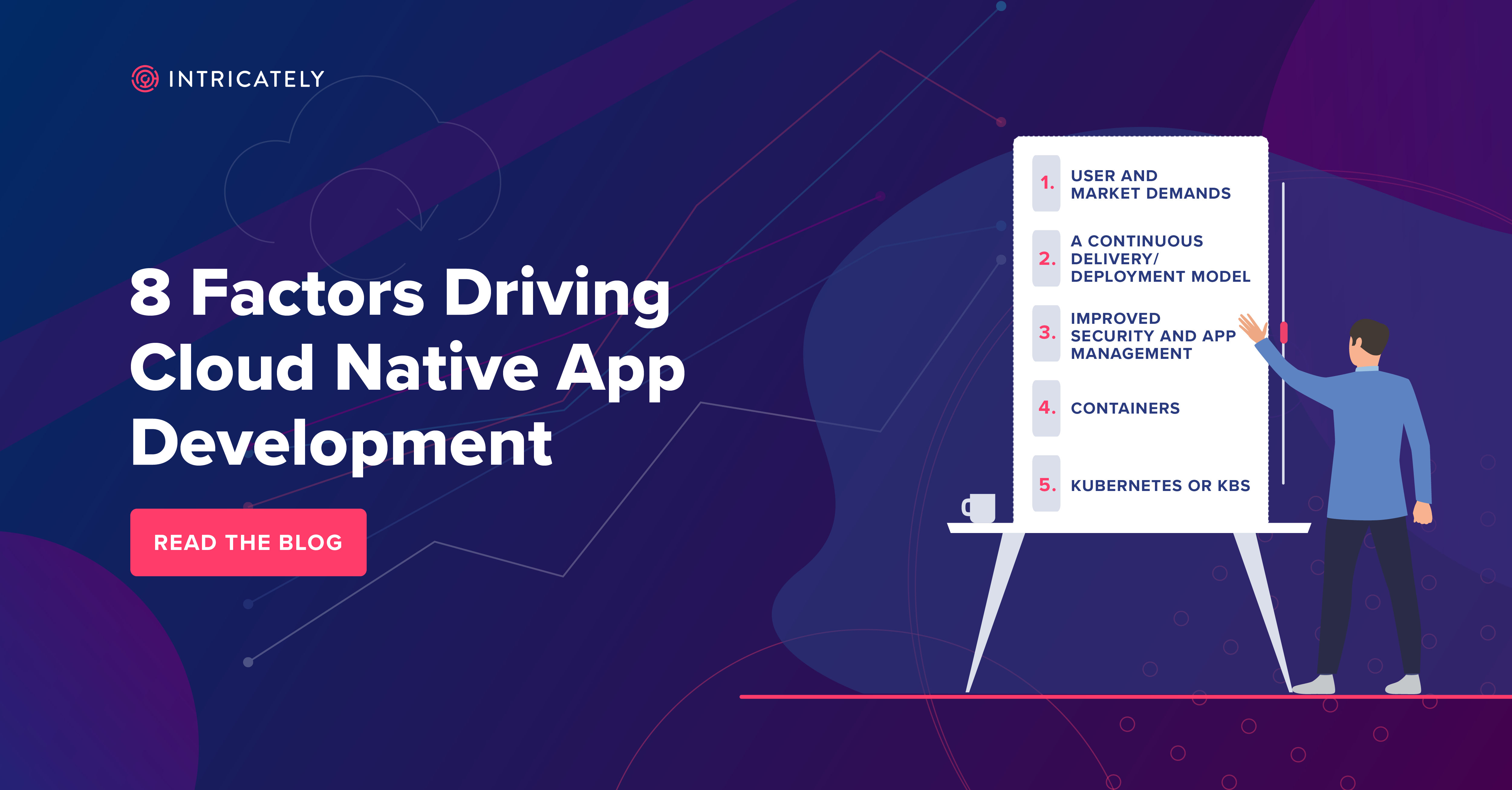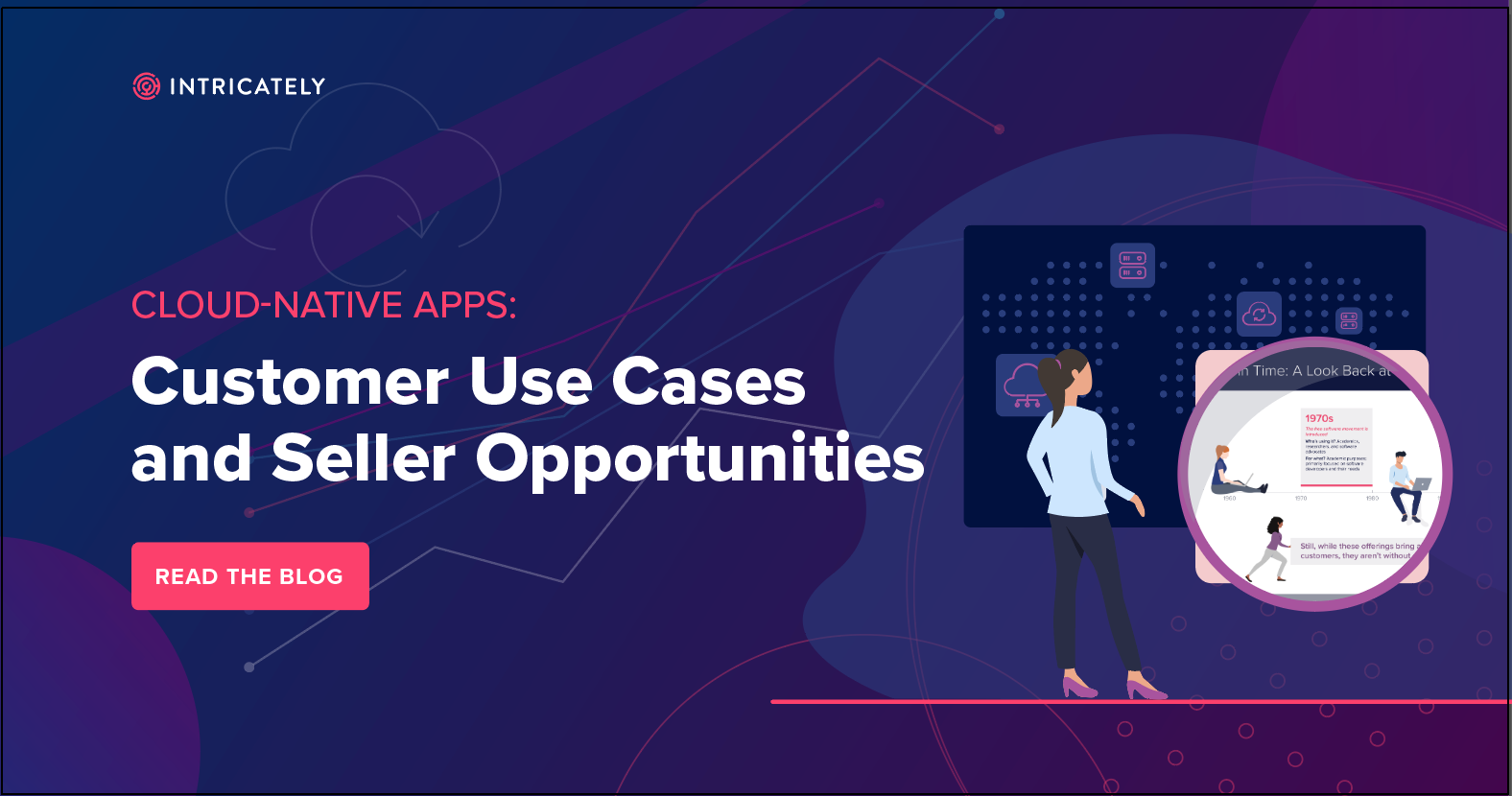
 back to all posts
back to all posts
The Growth of Cloud-Native Apps: Customer Use Cases and Seller Opportunities

Modern cloud infrastructure and cloud native applications are making software and app development not only faster – and thus more responsive to rapidly-evolving market/customer demands – but much cheaper and less labor intensive.
In the past, companies and their development teams needed their own IT infrastructure, often maintaining it on-prem and using waterfall approaches, wherein development would happen in timed sequences such as project analysis (1 month), project design (2-3 months), implementation and testing (2 months).
Post-waterfall, new approaches to app development have emerged
Not only were waterfall development processes expensive in terms of time and labor intensity, many never delivered on their anticipated value. As a result, software and app development concepts such as agile development, DevOps, and others came onto the scene. Today, cloud infrastructure and other cloud services have transformed the app development process, bringing massive efficiency benefits (more on those later).
Today’s users expect continuous innovation and almost real-time responsiveness to their evolving needs: a 6-month development cycle feels like 1985 all over again. Fortunately, this is where the evolution of the cloud has enabled app development and business systems to be more strategic and increasingly flexible in addressing customer demands for rapid software/app deployment.
Amazon.com, for example, famously deploys new software updates/changes multiple times per day based on the trends they see happening in real-time and based on A/B testing: they call it “continuous delivery.” Cloud native is all about moving fast and responding to evolving user needs, while also remaining agile.
Key terms in cloud-native computing
With cloud infrastructure and cloud native apps, we live in a much more efficient world of software and app development. This blog will explain how we got here, describing the cloud native technologies and trends that have driven a significantly more efficient and more market-responsive software/app development process. But first, let’s begin by gaining clarity around some relevant terms:
1. Cloud native applications are programs designed for a cloud computing environment. “Cloud native apps are designed and built to exploit the scale, elasticity, resiliency, and flexibility the cloud provides,” according to Oracle. Cloud native apps are built upon cloud-native architecture, which is an environment made specifically to exist in the cloud, as opposed to on-premises infrastructure.
2. Cloud native services enable efficient software/app development using technologies such as Kubernetes, Docker, serverless functions, APIs, and Kafka. “Cloud providers enable cloud tooling and services so developers can reduce operational tasks and build applications faster,” according to Oracle. Cloud native services give developers a comprehensive platform and menu of tools for building, deploying, and managing cloud native applications.
3. Containers are standard units of software that package up code (and all its dependencies) so the application runs quickly and reliably from one computing environment to another. A pre-packaged, pre-fabricated software container can be built for app X and then easily deployed for app Z. Containers are building blocks that support a “plug in and play” approach to app development and deployment.
4. Microservices, according to AWS, are “an architectural and organizational approach to software development where software is composed of small independent services that communicate over well-defined APIs.”
5. Kubernetes, also referred to as K8 or K8s, is a “portable, extensible, open-source platform for managing containerized workloads and services, that facilitates both declarative configuration and automation,” says the Kubernetes website. It was open sourced by Google in 2014 and is managed by the vendor-neutral Cloud Native Computing Foundation (CNCF). According to the CNCF, the number of developers using Kubernetes increased by 67% from Q1 2020 to Q1 2021. Kubernetes is the platform that containers sit upon.
Why companies are transitioning to cloud native development
Cloud native application development is booming because it’s significantly better – faster, less expensive, more flexible – than alternative approaches. It allows for a more agile (and continuous) development process that aligns better with the strategic needs of companies as market demands shift. A few other benefits include:
- Cloud native apps can scale up or down as needed and depending on usage demands, because their functions are broken into microservices that allow for individual management.
- Since cloud apps are agnostic to their cloud infrastructure, they can run in a highly distributed and flexible manner, maintaining independence and allocating resources based on the application’s needs.
- Cloud native applications provide a consistent experience across private, public, and hybrid clouds. That helps companies in terms of standardizing their brand “look and feel” across multiple channels.
The acceleration of container adoption: Sales opportunities
Intricately data shows that companies with open source software deployments spend $300 billion annually on cloud infrastructure, with $120 billion of that spent in the US. These companies turn to the cloud for software/app development help because it allows them to benefit from faster development cycles that are more responsive to market demands.
Gartner predicts that in 2022, more than 75% of global organizations will be running containerized applications in production, up from less than 30% in 2020.
By 2025, this number is expected to hit 85%.
The intertwined growth of open source software, containerization, and cloud native development will continue in the coming years. According to Gartner, cloud native platforms are “the keys to accelerating the adoption of the cloud, modern software management methodologies and infrastructure.”
As cloud sellers look to capitalize on market growth – much of it being driven by accelerating agility around app development and deployment – they need to understand where their customers and prospects are on their cloud adoption journey.
Companies that sell to cloud buyers can gain a competitive advantage by understanding exactly which cloud services a company has deployed, as well as the digital infrastructure supporting these applications. Having that cloud data can drive sales and marketing efforts, helping sellers better target prospects, engage them intelligently around present capabilities and future (cloud) plans/investments, and customize both messaging and offerings to address these identified customer needs.
Cloud market trends driving Kubernetes adoption
While larger enterprises lead the way in containerization, all companies that develop apps are headed in the same direction. So, what’s driving businesses to adopt Kubernetes? There are a few things:
- It's the “everything” platform. Applications running in containers is nothing new, but more organizations are also choosing to move their mission-critical applications (such as cybersecurity) to Kubernetes. “The Kubernetes control plane in particular is becoming a backbone of multi-cloud and hybrid cloud operations in general,” says Brian Gracely, Senior Director of Product Strategy at Red Hat. Containers are “must haves” for scaling any cloud infrastructure.
- It supports the cloud-native world. Cloud-native computing is quickly becoming a mature, fully-developed ecosystem. Kubernetes acts as the open source orchestrator in supporting apps across mixed information ecosystems, one where traditional IT infrastructure and cloud providers can coexist.
- A shift toward managed services. As more commercial Kubernetes platforms – like Red Hat’s OpenShift – continue to grow, market competitors will want to follow that growth. Analysts expect to see further expansion of managed Kubernetes cloud services, like Red Hat OpenShift on AWS (ROSA) and Microsoft Azure Red Hat OpenShift (ARO) because many companies don’t have the capabilities to run their own platform.
Increased multi-cloud adoption and maturity means more sales opportunities
According to Intricately data, 43% of all businesses are currently deploying more than five cloud applications. The more applications a company has deployed, the larger their budget – making them ideal opportunities for managed service providers. These more mature companies are digitally sophisticated, and their existing deployments signal their clear potential to invest in open source managed services.
The 9% of businesses with 20 or more applications deployed should be considered top prospects for cloud sellers and providers in 2022.
Again, having relevant cloud usage data on your customers and prospects can be a key driver of sales success. There’s plenty of cloud sales opportunities for everyone to thrive, or as VMware’s Head of Multi-Cloud, Marjorie Abdelkrime, explains it:
“There’s enough pie to go around for everyone. How we divide it up between the different cloud providers depends on how the customers are solving their own problems, and depends on their application development.”
For a full market analysis, download Intricately's 2022 Market Trends in Cloud-Native Computing Report
Intricately's 2022 Market Trends in Cloud-Native Computing Report offers an unparalleled view into the adoption, usage, and spend of cloud-native buyers and market trends around the world.
Download today for insights into how open source companies can grow and monetize their user base by offering managed services. We'll show you how to:
- Target prospects based on chosen hosting environment;
- Assess sales readiness based on number of applications deployed, and;
- Identify high-growth buyers spending over $100k/month on digital infrastructure
Intricately knows who your best customers are... do you?
Intricately’s Global Sensor Network actively monitors the adoption, usage and spend data of over 23,000 unique cloud products at over 7 million companies. Contact our team of experts to learn how we can help you drive more revenue by focusing on the right prospects.

3 Trends Shaping the Evolving Cloud Hosting Market

4 Ways Cloud Marketing Leaders Can Get the Most From Their Budgets in 2022

How to Perform Account Segmentation and Prioritization



Prospect Prioritization: How Intricately Solves the #1 Problem for Cloud Sellers


Intricately’s New Application-Level Data Set Enables Customized Outreach to Prospects



